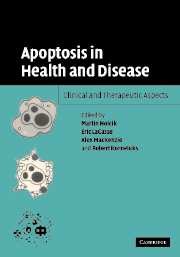Book contents
- Frontmatter
- Contents
- List of contributors
- Preface
- 1 Apoptosis in health, disease, and therapy: overview and methodology
- 2 Developmental apoptosis in health and disease
- 3 Apoptosis and cancer
- 4 Neuronal cell death in human neurodegenerative diseases and their animal/cell models
- 5 Apoptosis in the cardiovascular system: incidence, regulation, and therapeutic options
- 6 Cytotoxic lymphocytes, apoptosis, and autoimmunity
- 7 Pro- and anti-apoptotic strategies of viruses
- Index
- Plate section
- References
6 - Cytotoxic lymphocytes, apoptosis, and autoimmunity
Published online by Cambridge University Press: 03 March 2010
- Frontmatter
- Contents
- List of contributors
- Preface
- 1 Apoptosis in health, disease, and therapy: overview and methodology
- 2 Developmental apoptosis in health and disease
- 3 Apoptosis and cancer
- 4 Neuronal cell death in human neurodegenerative diseases and their animal/cell models
- 5 Apoptosis in the cardiovascular system: incidence, regulation, and therapeutic options
- 6 Cytotoxic lymphocytes, apoptosis, and autoimmunity
- 7 Pro- and anti-apoptotic strategies of viruses
- Index
- Plate section
- References
Summary
Introduction
Cytotoxic lymphocytes – you cannot live without them, but sometimes you have trouble living with them.the Jeckyl and Hyde character of these cells relates to their ability to induce death in target cells. On the one hand, they can recognize and destroy pathogenic cells, such as those infected with viruses, but, on the other hand, they can also mistakenly turn their attention to normal cells, resulting in autoimmunity. Lymphocytes can kill, either through direct cell contact or via the secretion of cytokines, and, in the case of B lymphocytes, antibodies. These secreted proteins are important in killing and autoimmune disorders. They can act directly but often function via the activation and/or recruitment of lytic and inflammatory effector cells. Most of the discussion in this chapter, however, will focus on the pathways that involve close apposition of effector and target cells. A knowledge of the molecular killing mechanisms used by cytotoxic lymphocytes may allow us to develop novel strategies to either curb or amplify target cell destruction. The current models for apoptosis induced by cytotoxic T lymphocytes (CTLs) and natural killer (NK) cells will be outlined, and some insights into which pathways are used in autoimmune disorders will be provided.
Over the last few years, it has become clear that CTLs and NK cells can kill via two distinct pathways. The first to be described involves the exocytosis of lytic proteins from dense granules in the cytoplasm of the effector cells toward the targets (Henkart, 1985).
- Type
- Chapter
- Information
- Apoptosis in Health and DiseaseClinical and Therapeutic Aspects, pp. 188 - 218Publisher: Cambridge University PressPrint publication year: 2005



